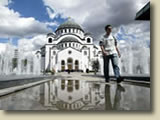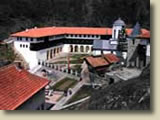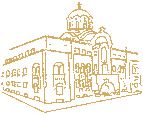|
|
Information
Service of
the Serbian Orthodox Church
May 15, 2004

MEETING OF CENTRAL BODY FOR COMPLETION OF ST.
SAVA CATHEDRAL
 The Central Body for completion of St. Sava Cathedral in Vracar
(Belgrade) met on Saturday, May 15, 2004 in the Belgrade Patriarchate.
All the members of the Holy Assembly of Bishops of the Serbian
Orthodox Church, as well as representatives of their respective
dioceses, took part in the meeting, where professor Dr. Vojislav
Milovanovic, the master builder of the Cathedral, presented a
report on the construction work completed during the past year. The Central Body for completion of St. Sava Cathedral in Vracar
(Belgrade) met on Saturday, May 15, 2004 in the Belgrade Patriarchate.
All the members of the Holy Assembly of Bishops of the Serbian
Orthodox Church, as well as representatives of their respective
dioceses, took part in the meeting, where professor Dr. Vojislav
Milovanovic, the master builder of the Cathedral, presented a
report on the construction work completed during the past year.
The following work was completed in 2003 and during the present
year up to this year's regular session of the Holy Assembly of
Bishops: All work on the installation of marble and granite on
the facade of the Cathedral was completed, as well as all work
on the construction of the parish home and St. Sava Square. Marble
plates were used to cover 9,600 square meters of the facade of
the cathedral, as well as 850 square meters of pillar elements,
portal windows, column capitals, doors, pilasters, for profiling
of granite base elements and many other details, totaling 2,700
tons. These tasks required the most contemporary organization,
planning and supervision of the work, which was carried out on
schedule. The building of wreaths of red granite on the cupola
and semi-cupolas was completed, as well as the large oak doors
with iron frames, and various cement, welding and other accompanying
work as foreseen at the last meeting of the Central body.
Plans for the interior were completed, and construction and
craftwork on installations and the artistic preparation of reliefs
on a surface of 1,200 square meters is currently in progress.
Panels in stone relief, according to the drawings of late architect
Aleksandar Deroko, are being prefabricated and their mounting
is planned in the next eight months. At the same time, work will
begin on the first 7.40 meters of parapet above which the panels
in stone relief will be placed. It is planned that the interior
of the church will be covered in mosaic, covering an area of
12,000 square meters which, God willing, will be done after the
installation of the relief plates.
 The entire complex (St. Sava Cathedral, the small St. Sava chapel
and the parish hall) are connected to the city's central heating
network. The entire complex (St. Sava Cathedral, the small St. Sava chapel
and the parish hall) are connected to the city's central heating
network.
During the period between the two meetings of the Central body,
the biggest and at the same time the only park square in Belgrade
– St. Sava Square – was completed. The builder and financier
of this project is the Belgrade Direction for Construction Property
and Building. The total surface area of St. Sava Square is 59,039
square meters: 34,400 square meters are green surfaces and 24,639
square meters are walkways. More than 1,100 deciduous and evergreen
trees, 1,000 various decorative shrubs, 200 meters of hedge,
800 rose bushes, 2,500 seasonal flowering plants... Complete
infrastructure has been constructed, including water supply,
sewage system, irrigation system, street lighting, fiber optic
cabling for television broadcasts...
At the same time, work on the construction and appointment of
a parish hall of approximately 2,000 square meters in surface
area was completed.
A financial report on the cathedral budget was presented by
Mr. Radivoje Minic, an official of the Cathedral Office. Members
of the Central Body expressed their satisfaction that work so
far has been completed on schedule and emphasized the need to
continue intensive collection of donations for the completion
of this heritage cathedral of the Serbian people. After the meeting,
the members of the Central Body, together with the Serbian hierarchs,
visited the Cathedral, where His Grace Bishop Mitrophan of Eastern
America, in the presence of relatives, served a requiem for all
deceased patrons-endowers, philanthropists and contributors to
the Cathedral. After the service, the members of the Central
Body visited the work site and saw everything that had been described
at the meeting.

PATRIARCH PAVLE AND MEMBERS OF THE HOLY ASSEMBLY OF BISHOPS
VISIT THE DIOCESE OF MILESEVO  At the invitation of His Grace Bishop Filaret of Milesevo, His
Holiness Patriarch Pavle, together with Their Eminences and Their
Graces the members of the Holy Assembly of Bishops of the Serbian
Orthodox Church, will visit the Diocese of Milesevo on Saturday
and Sunday. On Sunday, May 16, His Holiness Patriarch Pavle will
serve Holy Archierchal Liturgy in Holy Trinity Monastery near
Pljevlja, and then consecrate the renewed monastery residence
quarters. At the invitation of His Grace Bishop Filaret of Milesevo, His
Holiness Patriarch Pavle, together with Their Eminences and Their
Graces the members of the Holy Assembly of Bishops of the Serbian
Orthodox Church, will visit the Diocese of Milesevo on Saturday
and Sunday. On Sunday, May 16, His Holiness Patriarch Pavle will
serve Holy Archierchal Liturgy in Holy Trinity Monastery near
Pljevlja, and then consecrate the renewed monastery residence
quarters.
At 1:00 p.m. His Holiness Patriach Pavle will consecrate the
foundation of the new church of St. Nikolai of Ochrid and Zica
in the Prijepolje suburb of Kolovrat.
Holy Trinity Monastery is located about 1.5 kilometers from
Pljevlja. It was built on the remains of a monastery dating back
to the period of the Nemanjic dynasty. The first written historical
reference to Holy Trinity dates back to 1537, when it was mentioned
by hieromonk Sava, the first well-known Trinity copyist.
Renewed and expanded on several occasions, the monastery gained
its present-day shape in the 16th century when the main church
was built during the time of Abbot Visarion. At the end of the
16th century, the parvis was added on, the gift of the monk Georgije
Poblcanin, his son Ananije and the nephew of landowner Vojin.
Both the parvis and nave were decorated with frescoes before
the end of the 16th century. The frescoes were done by Father
Strahinja of Budimlje, an renowned fresco painter who decorated
many churches and monasteries at the end of the 16th and the
beginning of the 17th centuries.
In the 16th, 17th and 18th centuries Holy Trinity Monastery
was also known as a very significant copying and literary center.
Produced in the monastery were several dozen manuscripts, the
works of the Trinity dijaks (copyists). The most important artist
in this field was the famous Gavrilo of Trinity who between 1633
and 1651 copied numerous books, the most well-known among them
being the Sestodnev Jovana Egzarha (The Six Days of John Exarch),
the Kozma Indikoplov (Christian Topography), the continuation
of the Vrhobreznicki Hronograf (Vrhobreznica Chronograph – Vrhobreznica
is an earlier name for Pljevlja), many Psalters and several other
significant works. Creating in the monastery at the same time
as Gavrilo of Trinity was the illuminator and icon painter Andrija
Raicevic, who decorated the manuscripts of the Sestodnev and
Kozma Indikoplov with his highly successful miniatures. Several
icons created in the mid-17th century can also be traced back
to Raicevic.
Also protected in the monastery library are valuable books on
parchment and paper from the 13th and 14th centuries as well
as the famous, oldest on record correctional sheets from the
Milesevo press from 1557. The library also contains 824 Turkish
documents relating to the monastery itself or its numerous properties.
Unfortunately, some of the significant manuscripts created in
Holy Trinity are located in foreign museums and archives: a part
of the Vrhobreznicki Hronograf is in Prague, as is one psalter,
and the well-known Pljevlja Sluzbenik (Service Book) from the
14th century is in St. Petersburg. In addition to numerous valuable
church artifacts of silver, gold and wood for Divine Service,
the monastery treasury also contains valuable old textiles and
church embroidery, plate covers for books, the large gilded chalice
of Abbot Stefan, the well-known, silver plated staff of St. Sava,
received as a donation in 1576... It also contains items created
in the workshop of the known 16th century goldsmith Jovan Hocanin
(Focanin). Preserved in the monastery are the doors and two choir
sections wrought in rare and very valuable bone intarsia technique.
A fire in the monastery in 1859 completely destroyed its residence
quarters but expertly they were restored somewhat later and form
a harmonic whole with the church at their center. During the
entire period of Turkish rule, Holy Trinity Monastery was one
of the most important religious, educational, cultural and national
centers of the Serbian Orthodox population in not only the Pljevlja
region but also in Montenegro at the time, Old Raska and so-called
Hercegovacki Sanjak.


Copyright © 1999-2004 by
The Information Service of
the Serbian Orthodox Church
11000 Belgrade
Kralja Petra I no.5
+381 11 3282 596
e-mail
|

